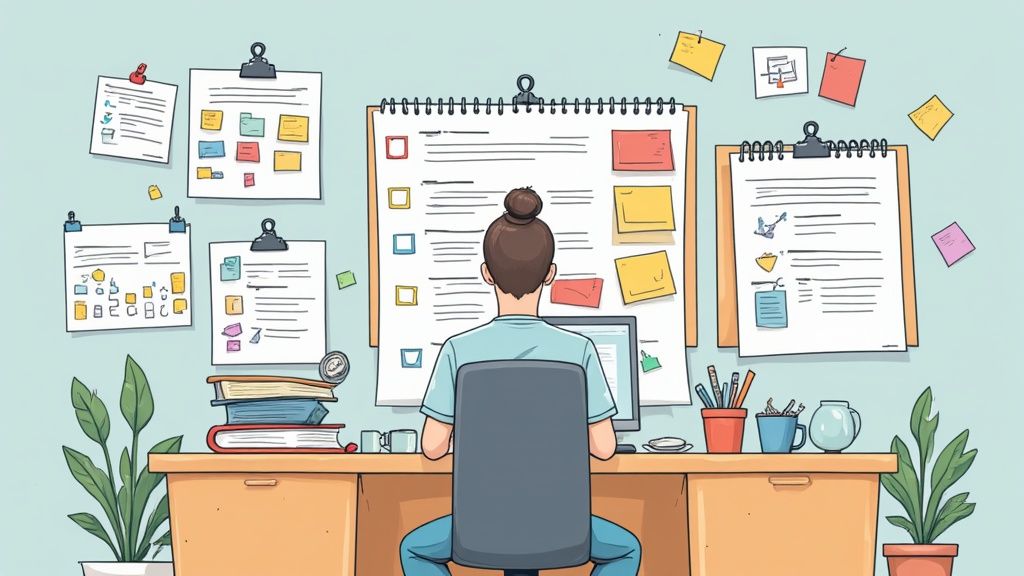How to Build Better Habits: A Science-Backed Guide to Lasting Change
Understanding the Science of Habit Formation

Want to build better habits? It's not just about willpower - it's about working with your brain, not against it. By understanding the science of how habits form, you can create lasting changes that stick. Let's explore how your brain creates and maintains habits.
The Habit Loop: Cue, Craving, Response, Reward
The habit loop is the foundation of how habits work in your brain. It has four key parts:
Cue: The trigger that starts the habit (like seeing your running shoes)
Craving: What you want from doing the habit (feeling energized after a run)
Response: The actual habit behavior (going for a run)
Reward: The benefit you get (post-run endorphins and satisfaction)
For example, the smell of coffee in the morning (cue) makes you want that energizing caffeine boost (craving). So you brew and drink your coffee (response) and get to enjoy both the taste and alertness (reward). Each time this loop repeats, the habit gets stronger.
Neuroplasticity: Your Brain's Ability to Change
Here's some good news: your brain is incredibly adaptable. Scientists call this neuroplasticity - your brain's ability to rewire itself by creating new neural pathways. Each time you perform a new behavior, you strengthen these pathways. With enough repetition, even long-standing habits can be changed.
The Timeframe of Habit Formation
Forget the myth about habits taking 21 days to form. Research shows it actually takes around 66 days for a new habit to become automatic for most people. This comes from studies tracking how long it takes for a behavior to reach its "plateau" point - where it feels natural and takes minimal effort.
You can find more detailed research on habit formation timelines here: Wonder Research on Behavior Change Statistics
Understanding this longer timeline helps set realistic expectations. Quick fixes rarely lead to lasting change. By knowing it takes about two months to build a solid habit, you can stay patient and consistent during those crucial early weeks when the habit is still forming.
Mastering Self-Control and Consistency
Good habits develop through a mix of mindful choices and steady practice. Success is not just about having iron willpower - it's about understanding how self-control and consistency work together. Let's look at how to build lasting habits without exhausting your mental energy.
The Role of Self-Control
Self-control helps most when you're first starting a new habit. It's what gets you out of bed for that early morning run or helps you pick a healthy lunch instead of fast food. Think of self-control as your starter motor - essential for getting going, but not what keeps you running long-term.
Consistency: The True Driver of Habit Formation
While self-control starts the process, consistency makes habits stick. Real progress comes from showing up regularly, even when you don't feel motivated. Research backs this up - a key study found that doing something consistently was far more important than willpower for building strong habits over time. Learn more about habit formation. The takeaway? Focus on regular practice rather than perfect performance.
Balancing Motivation and Discipline
Think of building habits like driving a car - you need both the ignition (self-control) and fuel (consistency). Relying on willpower alone is like trying to drive on starter power - you won't get far.
Motivation: Your reason for making changes - the destination you want to reach
Discipline: Your daily commitment - the regular steps that move you forward
Finding the right mix is key. Too much focus on discipline leads to burnout, while pure motivation fizzles out quickly.
Practical Strategies for Building Consistency
Here are proven ways to build habits without draining your willpower:
Start Small: Pick one habit to work on. Begin with easy steps you can manage daily.
Set a Schedule: Choose specific times and places for your new habit. This reduces the mental effort needed.
Keep Track: Note your progress, even small wins. This builds momentum and shows how far you've come.
Celebrate Progress: Give yourself credit for showing up. Small rewards help cement good habits.
Be Patient: Everyone slips up sometimes. Learn from setbacks and keep moving forward.
When you understand how self-control and consistency work together, you can build habits that last. Focus on steady progress rather than perfection. Small, consistent steps add up to big changes over time.
Designing Your Environment for Success

Success with new habits isn't just about motivation - your environment shapes your actions in powerful ways. The spaces where you live and work can either support or sabotage your goals. By thoughtfully arranging both physical and digital spaces, you make it easier to build positive habits.
Restructuring Your Physical Space
Think of your environment like setting up game pieces - you want to position everything to support success. Place important items where they naturally fit into your routine. For example, if you want to read more, keep a book on your nightstand instead of your phone. For healthier eating, rearrange your kitchen so nutritious foods are front and center while treats require more effort to reach. Small changes in item placement can have big effects on daily choices.
Creating Environmental Cues
Our brains respond automatically to environmental signals. You can use this to your advantage by setting up reminders that prompt desired behaviors. Want to stay hydrated? Keep a water bottle in view on your desk. Need to practice an instrument more? Leave it where you'll see it in your living room. You can also use sound cues - a gentle alarm can remind you to take breaks for movement during work. The more consistent these cues are, the stronger their effect becomes.
Minimizing Digital Distractions
Managing online spaces is just as important as physical ones for building good habits. If you need to focus, use tools like Freedom or Cold Turkey to block distracting websites temporarily. Keep your computer desktop clean and organized, and unsubscribe from email lists that don't serve you. A tidy digital workspace helps maintain focus just like a clean physical space does. By deliberately shaping your online environment, you set yourself up for success with the habits that matter most.
I made it feel more natural and engaging while keeping all the essential content and technical elements:
Building Better Habits With Strategic Linking

Making lasting changes isn't just about willpower. Habit stacking and strategic triggers offer proven ways to build new habits by connecting them to things you already do. When you link new behaviors to existing routines, you create natural cues that make good habits feel almost automatic.
How Habit Stacking Works
James Clear explains habit stacking beautifully in his book Atomic Habits. The concept is simple: attach a new habit to something you already do consistently. For example, after making your morning coffee, you might do 5 minutes of stretching. Your coffee routine becomes the reliable trigger that reminds you to stretch.
Finding Your Current Habits
Take a close look at your daily patterns. What do you do without thinking - checking your phone, brushing your teeth, or grabbing a morning shower? These automatic behaviors make perfect anchors for new habits. Pay attention to what sparks these actions too. Is it waking up? Getting home from work? Understanding these natural cues helps you build effective habit chains.
Building Your Habit Stack
Once you know your daily patterns, you can start linking new habits. Be specific about the connections. Instead of "I'll read more," try "When I get into bed, I'll read one chapter." Clear links make habits stick better.
Keep it simple: Stack one new habit at a time
Do it daily: Regular practice builds momentum
Write it down: Track your progress with Obsibrain's habit features
Using Environmental Triggers
Beyond your existing habits, your environment can prompt new behaviors. Strategic triggers might be:
A water bottle on your desk to remind you to hydrate
Running shoes by the door for morning exercise
A meditation cushion in plain sight
Making It Personal
Different triggers work for different people. Visual reminders might click for you, while time-based cues work better for others. Try various approaches to find what feels natural. The best system is one that fits smoothly into your life and matches how you naturally think and behave. When you combine smart habit stacking with personal triggers, you create a foundation for lasting positive change.
Building Powerful Progress Tracking Systems
Progress tracking plays a fundamental role in successful habit formation - giving you essential feedback, strengthening good habits, and keeping up your drive. You'll want to find a balanced approach to monitoring that avoids descending into obsessive tracking. Let's look at some proven tracking methods you can use, from basic paper systems to digital tools like Obsibrain.
Choosing the Right Tracking Method
The most effective tracking system is simply the one you'll stick with consistently. It needs to match your style, objectives and daily routine. Here are some proven approaches:
Digital Habit Trackers: Apps like Obsibrain make it easy to record daily progress, spot patterns, and set helpful reminders. This gives you a centralized system that works seamlessly with your Obsidian notes and productivity tools.
Spreadsheets: Though basic, spreadsheets offer flexibility to track and analyze data your way. Create visual charts, monitor streaks, and identify behavior patterns.
Journaling: Writing in a daily journal captures both your actions and your thoughts about them. This qualitative perspective reveals important insights about what drives or blocks your progress.
Habit Stacking and Triggers: Link tracking to strategic cues. For example, putting your water bottle on your desk reminds you to track water intake.
Paper Systems: Simple calendar checkmarks or a dedicated habit notebook gives you a clear visual of your consistency. This minimalist method works well for many people.
Measuring Meaningful Progress
Go beyond just checking off habits - note the quality of your efforts. If you're tracking exercise, record both that you worked out and specifics like intensity and duration. This comprehensive view helps identify where you can improve. The detailed feedback makes it easier to fine-tune your approach and maintain focus on growing over time.
Responding Strategically to Setbacks
Everyone faces setbacks. The key is seeing them as chances to learn rather than failures. When you miss a day or fall short, examine why. Was motivation low? Did your routine change? Something else? Use these insights to adjust and get back on course quickly. Regular self-reflection is crucial for lasting success.
Maintaining Momentum Through Challenging Periods
Life gets hectic. During tough times, habits often slip. Yet these are exactly when routines can provide stability. Adjust goals as needed - maybe do a 20-minute workout instead of an hour. Remember the 2-minute rule: Even minimal effort keeps the habit active and prevents complete derailment. Small wins build momentum for long-term progress.
Using Data Effectively Without Obsession
Let tracking inform your approach without controlling it. Don't get fixated on numbers. Habits are about sustained change, not daily perfection. Use tracking data to spot trends, celebrate wins, and learn from setbacks. But don't let it become a source of stress.
By creating an effective progress tracking system, you turn data into practical insights. This helps you build habits that truly last. Obsibrain's platform can support this process by connecting habit tracking with your broader productivity system.
Overcoming Advanced Habit-Building Obstacles

You've got the basics down - the habit loop, consistency, and environment design. But what happens when unexpected challenges pop up? Let's explore practical ways to keep your habits strong when life gets messy.
Maintaining Momentum During Motivation Dips
We all face times when motivation fades. The "2-minute rule" is a simple but powerful fix - just commit to doing your habit for two minutes when you're not feeling it. Once you start, you'll often find yourself naturally continuing longer. This small commitment can prevent your habits from falling apart.
Adapting to Major Life Changes
A new job, moving homes, or family changes can throw off your routines. The key is to identify your essential habits and find creative ways to keep them going. Maybe that means finding a gym near your new place or carving out 15 minutes for reading during your lunch break.
Recovering From Significant Setbacks
Getting sick, injured, or falling off track happens to everyone. Instead of beating yourself up, use setbacks as learning opportunities. Take time to figure out what triggered the slip-up and make a clear plan to handle similar situations better next time.
Troubleshooting Common Habit-Building Challenges
Here's how to tackle the most common habit hurdles:
Trying to change too much: Pick just one or two key habits to focus on at a time
Limited time: Break habits into tiny chunks - even 5 minutes counts
Changing environments: Create portable routines you can do anywhere
Self-criticism: Focus on progress over perfection and celebrate small wins
Advanced Strategies for Habit Resilience
Try these proven approaches to make your habits stick:
Monthly check-ins: Review what's working and what needs adjusting
Backup plans: Have alternatives ready when your usual routine isn't possible
Track your feelings: Notice how your habits affect your mood and energy
Build support: Share your goals with friends or join online communities
Building better habits is an ongoing process - there's no finish line. The real skill is learning to adapt when things get tough. Want help tracking your habits? Obsibrain makes it simple to build and maintain positive routines in Obsidian. Start strengthening your habits today.
Last updated
Was this helpful?